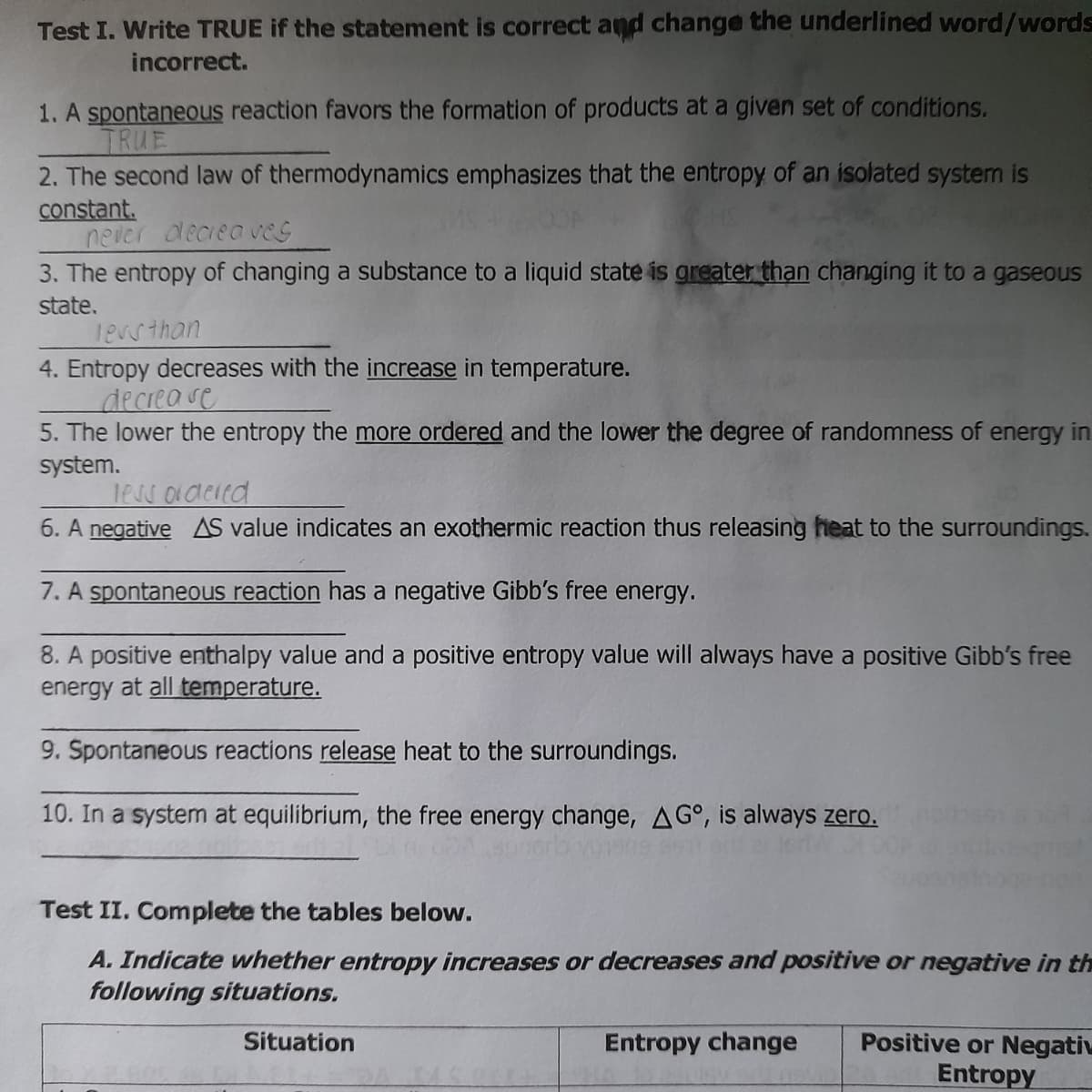1. A spontaneous reaction favors the formation of products at a given set of conditions. TRUE 2. The second law of thermodynamics emphasizes that the entropy of an isolated system is constant. never dleciea veG 3. The entropy of changing a substance to a liquid state is greater than changing it to a gaseous state. 18u5than 4. Entropy decreases with the increase in temperature. decreave 5. The lower the entropy the more ordered and the lower the degree of randomness of energy in system. less ardeied 6. A negative AS value indicates an exothermic reaction thus releasing heat to the surroundings 7. A spontaneous reaction has a negative Gibb's free energy. 8. A positive enthalpy value and a positive entropy value will always have a positive Gibb's free energy at all temperature. 9. Spontaneous reactions release heat to the surroundings. 10. In a system at equilibrium, the free energy change, AG°, is always zero.
1. A spontaneous reaction favors the formation of products at a given set of conditions. TRUE 2. The second law of thermodynamics emphasizes that the entropy of an isolated system is constant. never dleciea veG 3. The entropy of changing a substance to a liquid state is greater than changing it to a gaseous state. 18u5than 4. Entropy decreases with the increase in temperature. decreave 5. The lower the entropy the more ordered and the lower the degree of randomness of energy in system. less ardeied 6. A negative AS value indicates an exothermic reaction thus releasing heat to the surroundings 7. A spontaneous reaction has a negative Gibb's free energy. 8. A positive enthalpy value and a positive entropy value will always have a positive Gibb's free energy at all temperature. 9. Spontaneous reactions release heat to the surroundings. 10. In a system at equilibrium, the free energy change, AG°, is always zero.
Chemistry
10th Edition
ISBN:9781305957404
Author:Steven S. Zumdahl, Susan A. Zumdahl, Donald J. DeCoste
Publisher:Steven S. Zumdahl, Susan A. Zumdahl, Donald J. DeCoste
Chapter1: Chemical Foundations
Section: Chapter Questions
Problem 1RQ: Define and explain the differences between the following terms. a. law and theory b. theory and...
Related questions
Question
Write True if the statement is correct and change the underlined word if incorrect. Thx

Transcribed Image Text:Test I. Write TRUE if the statement is correct and change the underlined word/words
incorrect.
1. A spontaneous reaction favors the formation of products at a given set of conditions.
TRUE
2. The second law of thermodynamics emphasizes that the entropy of an isolated system is
constant.
never deciea veG
3. The entropy of changing a substance to a liquid state is greater than changing it to a gaseous
state.
18v5than
4. Entropy decreases with the increase in temperature.
decrease
5. The lower the entropy the more ordered and the lower the degree of randomness of energy in
system.
less oldeied
6. A negative AS value indicates an exothermic reaction thus releasing heat to the surroundings.
7. A spontaneous reaction has a negative Gibb's free energy.
8. A positive enthalpy value and a positive entropy value will always have a positive Gibb's free
energy at all temperature.
9. Špontaneous reactions release heat to the surroundings.
10. In a system at equilibrium, the free energy change, AG°, is always zero.
Test II. Complete the tables below.
A. Indicate whether entropy increases or decreases and positive or negative in th
following situations.
Positive or Negati
Entropy
Situation
Entropy change
Expert Solution
This question has been solved!
Explore an expertly crafted, step-by-step solution for a thorough understanding of key concepts.
Step by step
Solved in 3 steps

Knowledge Booster
Learn more about
Need a deep-dive on the concept behind this application? Look no further. Learn more about this topic, chemistry and related others by exploring similar questions and additional content below.Recommended textbooks for you

Chemistry
Chemistry
ISBN:
9781305957404
Author:
Steven S. Zumdahl, Susan A. Zumdahl, Donald J. DeCoste
Publisher:
Cengage Learning

Chemistry
Chemistry
ISBN:
9781259911156
Author:
Raymond Chang Dr., Jason Overby Professor
Publisher:
McGraw-Hill Education

Principles of Instrumental Analysis
Chemistry
ISBN:
9781305577213
Author:
Douglas A. Skoog, F. James Holler, Stanley R. Crouch
Publisher:
Cengage Learning

Chemistry
Chemistry
ISBN:
9781305957404
Author:
Steven S. Zumdahl, Susan A. Zumdahl, Donald J. DeCoste
Publisher:
Cengage Learning

Chemistry
Chemistry
ISBN:
9781259911156
Author:
Raymond Chang Dr., Jason Overby Professor
Publisher:
McGraw-Hill Education

Principles of Instrumental Analysis
Chemistry
ISBN:
9781305577213
Author:
Douglas A. Skoog, F. James Holler, Stanley R. Crouch
Publisher:
Cengage Learning

Organic Chemistry
Chemistry
ISBN:
9780078021558
Author:
Janice Gorzynski Smith Dr.
Publisher:
McGraw-Hill Education

Chemistry: Principles and Reactions
Chemistry
ISBN:
9781305079373
Author:
William L. Masterton, Cecile N. Hurley
Publisher:
Cengage Learning

Elementary Principles of Chemical Processes, Bind…
Chemistry
ISBN:
9781118431221
Author:
Richard M. Felder, Ronald W. Rousseau, Lisa G. Bullard
Publisher:
WILEY